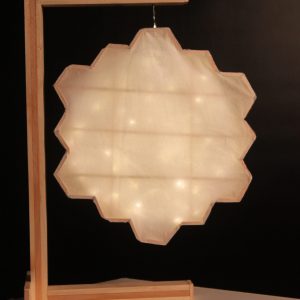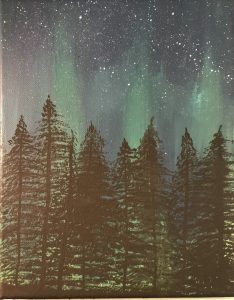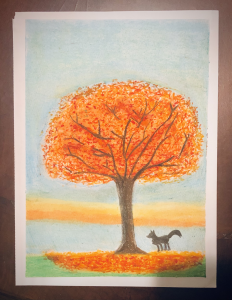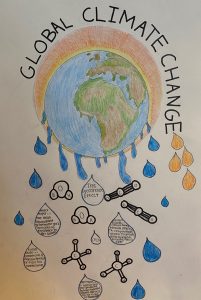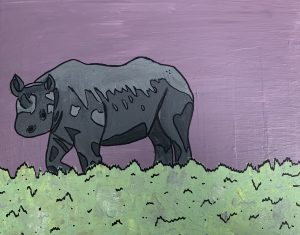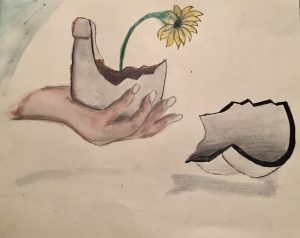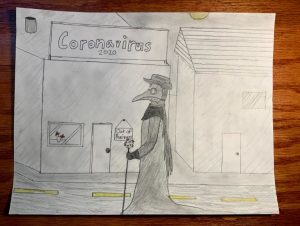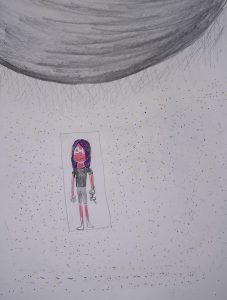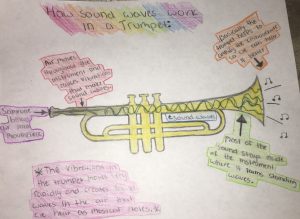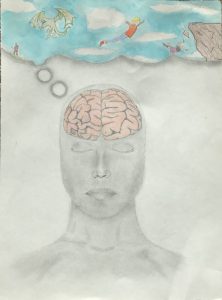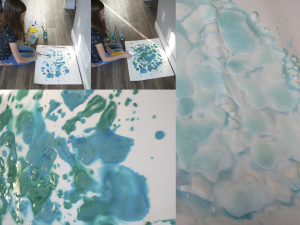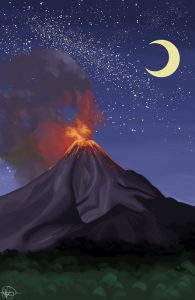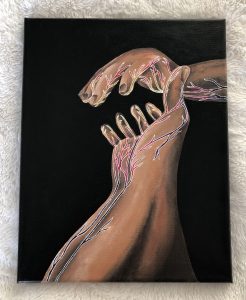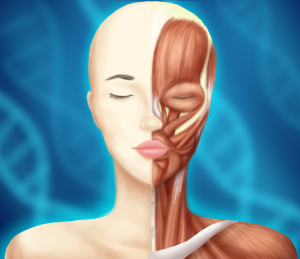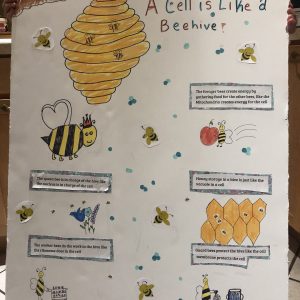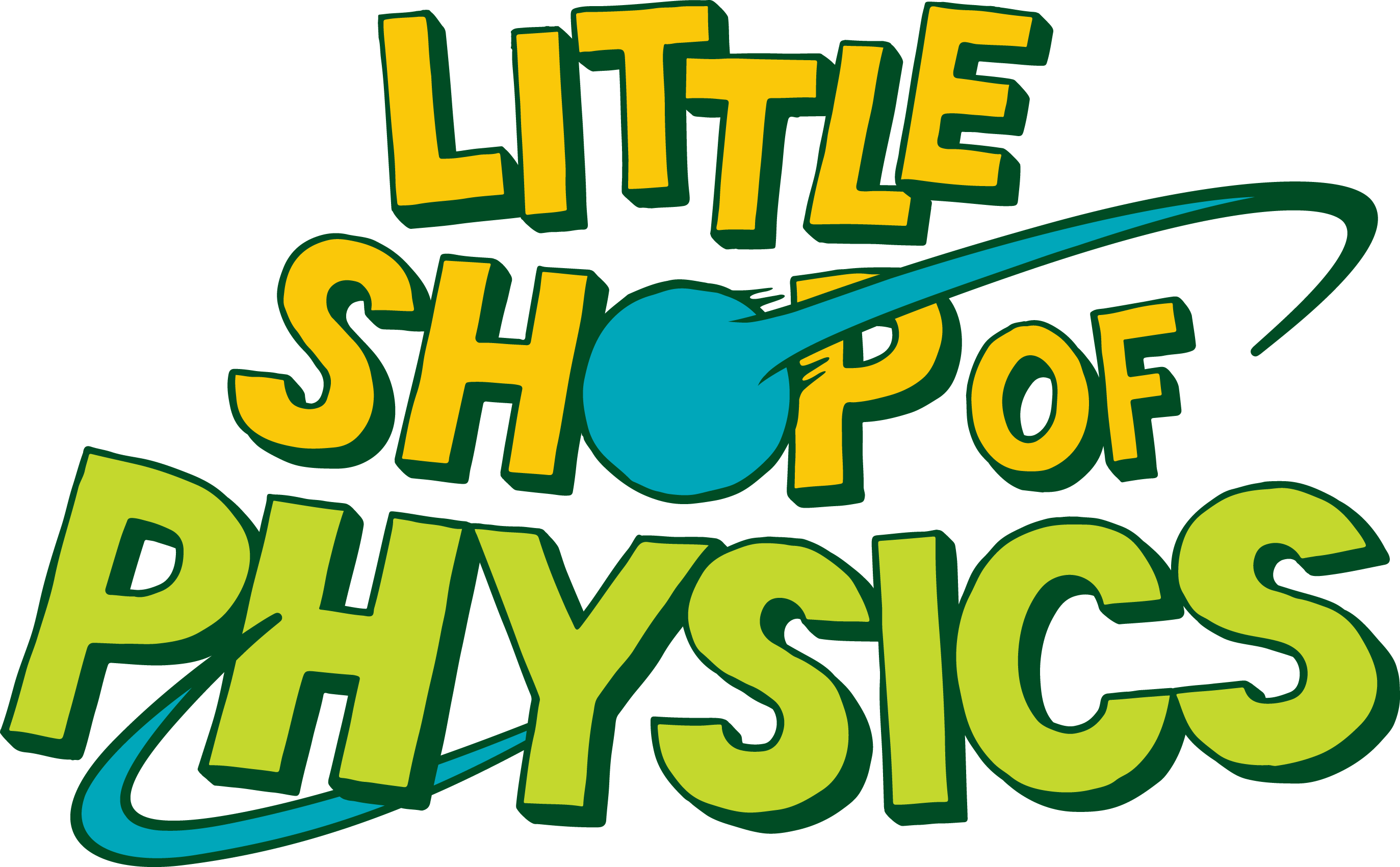Art of Science Contest — Fall 2020
This contest ran through October 31, 2020 and was open to all students enrolled in grades 6-12 in a public or private school in the United States. Students were asked to submit an original science-inspired artistic composition in any field of science using any artistic medium. Entrants were able to connect with Colorado State University students and staff students and staff to help them develop ideas for their entries. Every entry was evaluated by our team of CSU students and staff, and every entrant will receive detailed feedback on their submissions. Winners will receive certificates and awesome prizes!
For the latest on the Art of Science contest, please click here. Below are the winners!
Best in Show
Honeycomb Conjecture Lamp
by Emma Sudo, 10th grade, Deerfield Academy
Why are honeycombs made out of regular hexagons and not other types of shapes? Marcus Terentius Varro proposed the “Honeybee Conjecture” over 2000 years ago to answer this question. The Honeycomb Conjecture states that a grid made of regular hexagons is the best way to create regions of equal area with the least perimeter and was proven by Thomas Hales. Bees build each cell of a honeycomb simultaneously to be efficient which means that every cell needs to be uniform for them to fit together without gaps or overlaps. This is why it is helpful for each cell to have an equal area and equal side lengths. Bees need each cell to have the smallest perimeter so that they waste the least amount of wax. Furthermore, there are only three regular polygons that produce regular tesselations: the square, the equilateral triangle, and the regular hexagon. Humans don’t appreciate the ingenuity of insects enough, so I created this lamp in hopes that more people would notice how intelligent bees are and realize that nature and mathematics often converge in places that we would least expect to create beautiful works of art.
Materials: plywood, tissue paper
- Sources:
Hales, T. C. (2001). The Honeycomb Conjecture. Discrete & Computational Geometry, 25(1), 1–22. https://doi.org/10.1007/s004540010071 - Krulwich, R. (2013, May 13). What Is It About Bees And Hexagons? NPR. https://choice.npr.org/index.html?origin=https://www.npr.org/sections/krulwich/2013/05/13/183704091/what-is-it-about-bees- and-hexagons
Best Representation of a Concept, Experiment, or Achievement in the Physical Sciences
Aurora Borealis
by Abagail Wolfe, 8th grade, Cache La Poudre Middle School
The aurora borealis also known as the northern lights is known for its iconic bright colors in the sky. The cause of these bright colors in the sky is the solar wind. The solar wind is created by the hot gases from the sun made up of electricity called ions. When the solar wind approaches earth it gets blocked by the earth’s atmosphere. The atmosphere blocks most of the solar wind out but a few ions get trapped in some areas. These areas with ions that get trapped in the atmosphere are called the ionosphere. The ionosphere is located around the Earth’s geomagnetic poles. In the ionosphere, the solar wind collides with oxygen and nitrogen from the Earth’s atmosphere, and while they are colliding energy forms creating bright colors in the sky known as the aurora borealis. But before we knew how the aurora borealis or northern lights were created there was mythology on the matter. The word aurora borealis comes from the Greek words aurora meaning sunrise and borealis meaning wind. The Greek myth says that “Aurora was the sister of Helios and Seline, the sun and moon respectively, and that she raced across the early morning sky in her multi-colored chariot to alert her siblings to the dawning of a new day.” There are other myths and stories from other cultures too like Europe, China, Japan, Australia, Iceland, Greenland, and others. Since there are myths on the aurora borealis from different cultures all around the world, people come all around the world to see the beautiful lights. Think about this that only about one 6000th of the world’s population can experience the aurora borealis also known as the northern lights. I hope someday that I could be one of those people to see aurora borealis and there iconic bright colors in the sky.
Best Representation of a Concept, Experiment, or Achievement in the Life Sciences
Autumn’s Gift
by Ruth Karan, 9th grade, Poudre High School
During the fall, trees present us with a beautiful gift – the gold, orange, and red colored leaves that give the season its magical aura. The original green color of leaves is transformed due to the changes in temperature and span of daylight that autumn brings. With the cooler temperatures and shorter days, the green color gives way to the unique hues and shades of orange and yellow. During this developmental process, known as senescence, the chlorophyll, which is the green pigment of a leaf, is broken down before it falls, unveiling the yellow and orange colors of the carotenoid pigments. In my drawing, I portray this intriguing way of aging through the various colors of leaves depicted on the Maple tree and the fallen leaves around it. Beneath the tree a silhouette of a red fox is shown, a magnificent animal that begins to reveal its elegant coat of fur during the autumn season. I created my artwork using a variety of tools including oil pastels, paint pens, colored pencils, and watercolors. I used oil pastel techniques such as light pressure blending (to design the background) and stippling (to create the leaves of the tree).
Sources:
Best Representation of a Scientific Issue of Social Importance in the Physical Sciences by a High School Student
Global Climate Change
by Karson Powers, 11th grade, Cherry Creek High School
This artwork was drawn to represent climate change and the green house gases that are factors of it.
Sources:
Best Representation of a Scientific Issue of Social Importance in the Life Sciences by a High School Student
Southern Black Rhino
by Emory Wheeler, 11th grade, Prospect Ridge Academy
This is a painting of a southern black rhino. The southern black rhinos are being poached for their horns, causing their population to dwindle. The minimalist painting style shows how an animal might just seem like an animal and doesn’t have much impact. The loss of southern black rhinos will and do have an impact on the balance in their ecosystem. These animals may seem like a little piece in a big puzzle but they are still an important piece in the big puzzle. Many animals have gone extinct and the ecosystem had to react and change but that doesn’t happen overnight. We need to learn how to stop poachers from killing innocent animals for their own prosperity. These animals are at our mercy and they were here before us and we need to protect them. The southern black rhinos are just another animal at the edge of extinction that humans have caused but they deserve to live.
Sources:
I used an image form https://fossilrim.org/animals/southern-black-rhinoceros/ to create an accurate image of a southern black rhino.
Best Representation of a Scientific Issue of Social Importance in the Physical Sciences by a Middle School Student
Climate Change
by Danielle Doyle, 8th grade, Lesher Middle School
Climate change informs us about the different changes in the average conditions, Such as rainfall and temperatures. Over a long period, NASA scientists have been observing the Earth’s surface for warming. The wave I chose to focus on is heatwaves, So I chose climate change, which is when the sun/heatwaves warm up the Earth’s surface, then the Earth radiates energy back to the atmosphere into space. Some of the greenhouse gases trap and absorb some of the radiation off of the Earth’s surface. Which is why there is heat in all directions even towards the ground. Climate change was first discovered in the 19th century, by a guy named Guy Callendar who is an amateur scientist who not only discovered climate change 80 years ago. But also built the first climate change model to predict it as well. Global temperatures have increased by 1° Celsius in the past century. Climate change is not only global warming driven by human emissions of greenhouse gases but is also sadly resulting in large-scale changes in weather patterns. I chose to draw this to promote awareness of greenhouse gasses because rainfall is getting trapped and our Earth is getting dry.
Sources:
Best Representation of a Scientific Issue of Social Importance in the Life Sciences by a Middle School Student
Covid Doctor
by Wade Faulkner, 7th grade, Polaris Expeditionary Learning School
Scientists say that there are two big things that could wipe out mankind, one, a meteor, big enough to kill people like the dinosaurs, two, a pandemic. A pandemic is an outbreak of a disease, that usually spreads throughout the world. We have had many pandemics and one of the more deadly pandemics was the Black Plague, 1347 to 1351. The Black Plague alone wiped out half of Europe. And today we also have a pandemic, the Covid-19 outbreak. Covid-19, or Coronavirus, started out in China and has spread throughout the world. But unlike the Black Plague outbreak, now we have soap, medicine, and many doctors working hard to make a vaccine. And that’s why I’ve chosen to make a drawing about Covid-19. In my drawing, you’ll see a Plague Doctor from the Black Plague pandemic, you’ll notice that they are carrying a staff with the Coronavirus on top, they are walking through a town that Covid-19 is effecting. As though the Plague Doctor was brought from the past to help with the disease. That’s why my drawing is titled, ‘Covid Doctor’.
Sources:
Best Use of Humor to Explain a Concept in the Physical Sciences
Juan’s Big Mistake
by Weldon Sarmiento, 9th grade, Poudre High School
This is an example of what not to do in a science lab.
Best Use of Humor to Explain a Concept in the Life Sciences
Terrific Tan Lines
by Calista Carroll, 8th grade, Lesher Middle School
To begin I chose U.V rays/radiation. U.V stands for ultraviolet which is a wave on the electromagnetic spectrum. The person who discovered U.V rays/Radiation was a man named Johann Wilhelm Ritter. The year he discovered it was in the year 1801. U.V rays are used for many things like tanning salons, blacklight, killing bacteria, and creating fluorescent effects. For the art of science submission, I chose to draw a picture. In the picture, you see a person that looks red, because they got sunburnt. You can tell the person has tan lines right around their eyes where their sunglasses were. Right above the person, you can see a roundish object. That’s meant to look like the sun. Also, the little lines right around the sun are supposed to look like heat coming off the sun. Lastly, the little dots in the background is meant to look like sand. That is my description of my picture.
Sources:
- https://pubmed.ncbi.nlm.nih.gov/16383017/
- https://astronomy.swin.edu.au/cosmos/u/ultraviolet
- https://www.cancer.org/cancer/cancer-causes/radiation-exposure/uv-radiation.html#:~:text=UV%20rays%2C%20either%20from%20the,can%20also%20cause%20eye%20problems.
- https://www.ccohs.ca/oshanswers/phys_agents/ultravioletradiation.html#:~:text=UV%20radiation%20is%20widely%20used,are%20used%20for%20different%20purposes.
- https://sites.google.com/site/uvraysallyouneedtoknow/interesting-facts-2
Most Creative Representation of Something That Normally Cannot Be Seen or Heard in the Physical Sciences
How Sound Waves Work In A Trumpet
by Julia Edwards, 8th grade, Lesher Middle School
I decided to draw a diagram with an explanation of how sound waves work and produce sound in a trumpet. A person blows air into the mouthpiece and the air travels throughout the trumpet vibrating rapidly which causes sound waves to be formed. The vibrations in the trumpet move very rapidly and create sound waves in the air that we hear as musical notes. But most of the sound actually stays inside of the instrument where it forms a standing wave that feeds off of the energy from the player’s lips. So basically, the trumpet helps to sort of amplify the embouchure so we can hear the sounds better. In my diagram, I point out where the sound waves are and other kinds of important things.
Sources:
Most Creative Representation of Something That Normally Cannot Be Seen or Heard in the Life Sciences
While you were sleeping…
by Iris Hicks, 8th grade, Cache La Poudre Middle School
We spend one-third of our lives sleeping, so why is it so important? How does it help our brains grow and develop? One concept is that it lets our brains remove toxins, and keep important information. This can improve your memory, and keep you healthier overall. Dreaming while we sleep is also important in restoring memories. When our brain replays information while we are dreaming then it establishes what we may remember later on. During REM sleep, Memory Consolidation can occur which is when new knowledge of something can turn into long-term memories. For my work I drew a person sleeping, and I colored in the brain showing it’s active, although the brain is actually grey. There is a “dream” displayed above the head with a few different common dreams. So how many memories could we lose if we didn’t dream, what effects would it have on the brain if we never got any sleep?
Sources:
Most Creative Use of Science to Make Art
Solid, liquid, and gas
by Ramona Dixon, 6th grade, Preston Middle School
My project combined a science experiment with a painting. I made a baking soda paint combining water, baking soda, and food coloring. After putting that on the paper, I sprayed it with vinegar. The vinegar reacted with the baking soda and created bubbles. Because all states of matter are represented, I decided to call it solid, liquid and gas.
Sources:
Best Visual Art Composition in the Physical Sciences by a High School Student
Calm Disaster
by Alanna Bradshaw, 11th grade, Cherry Creek High School
When my science teacher Ms. Paracio talked about the art competition CSU holds every year I knew I wanted to participate. Everything about the competition excited me. It combined a few of my favorite things, art and science, while also being held by my dream college. With all of that being said, I decided to submit a piece. What was the worst that could happen? When I saw the prompt I was a little stumped on what I wanted to do. I really wanted to challenge myself while still having fun. I have been drawing for years but The one thing that I’ve always struggled with is nature and landscapes. That is why I came to the decision on a volcano after narrowing down my plan to earth science. Once I decided on a piece I scrolled through as many pictures of volcanoes as I could find. Once I had a composition in mind, I started my piece. I wanted the volcano to be erupting yet still seem far away and docile. I chose the cooler color pallet for the foreground and background to allow the eruption to be the centerpiece of the artwork. After hours of working and reworking I am proud of the composition I ended up with, and hope that you will be too.
Best Visual Art Composition in the Life Sciences by a High School Student
The Touch
by Emma Schauble, 10th grade, Prospect Ridge Academy
Our body is full of hidden functions that help us feel. One of the largest and most complex bodily functions is our nervous system. While the nervous system affects many parts of our body, it also allows us to feel and move. Nerves are all over our body, allowing us to sense heat, cold, others touch, and many other things. In my piece, I wanted to show or highlight the things that we cannot see, our nerves. I included two hands reaching for each other, in the hands I have shown the nerves, the nerves grow brighter as the two hands get closer to each other. The shift in colors of the nerves from yellow to blue represents the closeness of the hands, the closer they are, the more heat they can feel.
Sources:
Best Visual Art Composition in the Life Sciences by a Middle School Student
Your Muscles
by Sasha Vorontsova, 7th grade, Casey Middle School
Our muscles play a significant role in helping our body function. Yes, they allow us to move, but they also do so much more. Our bodies consist of three different types of muscles, skeletal, smooth, and cardiac. Skeletal muscles are, I’d say, the ones you think of first. They help you do stuff like move and lift things. All your skeletal muscles connect directly to the bone, except for in one area. Many of your facial muscles also attach to the underside of your skin. This allows you to make hundreds of different expressions with the slightest movement. Smooth muscles are involuntary, meaning you don’t control them. They are usually in layers or sheets and are found in places all over your body. Some examples include in your stomach, eyes, and bladder. Also known as your heart, the cardiac muscle contracts and relaxes to pump blood through your entire body and back. Like smooth muscles, your cardiac muscle is also involuntary. Our muscles are fundamental to our survival and help us do everything from digesting our food to showing our emotions.
Best Written Composition
The Cells Family, A Short Story
by Olivia Helgerson, 7th grade, Lesher Middle School
The Cells Family: A Short Story (pdf)
My analogy was a cell is like a family. I think this because there is a boss of a cell and boss of a family, someone who stores food and waste, someone who transports everybody in the family. I also think that a cell is like a family because everything in the cell is so close, just like a family.
Cell Membrane- The mother. A mother is in charge of supporting the family and making sure that no bad information goes into the kids and only good information like how the cell membrane protects and supports the cell.
Endoplasmic Reticulum (ER)- Older brother. The older brother is in charge of transporting the younger siblings, especially when the parents can not like how the ER transports materials.
Lysosome- The family dog. The dog chews up everything, so he is getting rid of (and making) waste! He also likes to use the indoor plants as trees like how the Lysosome disposes of the waste in the cell.
Mitochondria- The younger brother. He is always encouraging and makes everyone excited for little activities like cleaning the house like how the mitochondria provides the cell with energy! Nucleus- The father. He does the directions on road trips and always knows how to fix an issue like how the nucleus has the “instructions” for the cell.
Ribosome- The sister. She is always playing with dolls, which creates (in her mind) new members of the family. Just like how the ribosome makes proteins!
Vacuole- That one weird cousin. We all know them, they take all the food at family gatherings. They will stock their plate up with food and water and hide in the bathroom. Just how the vacuole stores water, food, and waste for the cell.
Honorable Mention
At Play (A Musical Composition)
by Sofia Rodriguez, 8th grade, Lesher Middle School
My name is Sofia Rodriguez. The name of my composition is “At Play”, because of it’s mischievous nature and child-like attitude. The song is entirely written in pizzicato, or plucking strings. This simulates the idea of children hopping around, and adds an aura of lightness and playful fun. I wrote it using the app GarageBand (https://apps.apple.com/us/app/garageband/id408709785). I studied sound waves in string instruments, and composed this. Sound waves vibrate when you pluck the strings, and these vibrations create waves, which create sound. The sound is more high pitched the thinner the string is because this shortens the wavelength. The volume is also changed by how hard you pluck or press, which causes a higher amplitude in the waves and therefore a louder volume. Although I used an online app, this still simulates the way an actual instrument sounds even if not the way it works. String instrument have been around sense Ancient Mesopotamia, and to this day we are still inventing ways of making music. From classical string instruments to electronic apps like this one, I have no doubt music will continue to find new ways of using sound waves. The following are websites I used to research sound waves in string instruments:
Sources


